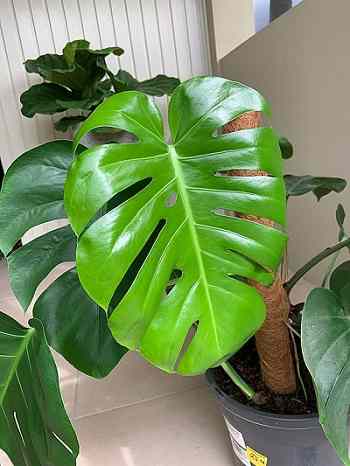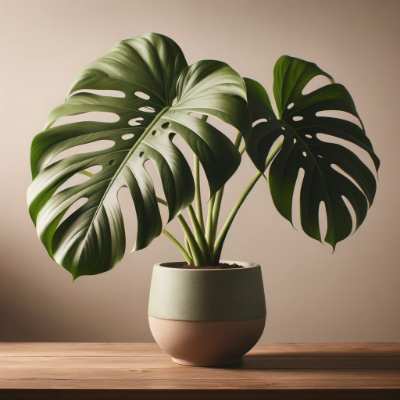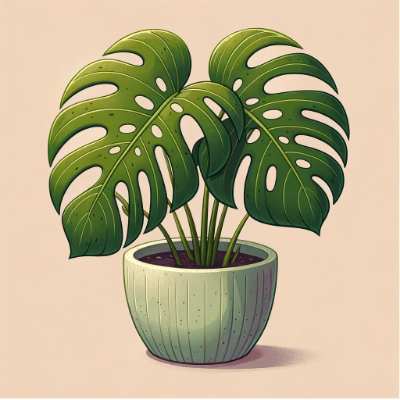There are many special styles of plants, every with their own particular that means and symbolism. Some plant life, which include the rose, have received cultural meanings beyond their easy botanical designation. The Monstera plant is one such plant with a range of various meanings and associations.
Monstera Plant Meaning – Monstera plant is a symbol of accurate luck, toughness(rapid leaf increase), protection, spiritual peace, respect towards elder humans and prosperity. They are also referred to as the “plant of the gods” and are native to the rainforest in Central and South America. Monstera vegetation are recognised for their huge leaves that could grow up to 10 ft lengthy and their sturdy, thick stems that can hold up to 2 hundred kilos of weight. They are also very easy to care for, wanting simplest water and sunlight to thrive.
| Profile of Monstera Plant | |
|---|---|
| Botanical Name | Monstera deliciosa |
| Soil Type | Peat-based Soil mix Required well-drained |
| Height | 3 ft. tall |
| Plant Type | Climbing evergreen |
| Flower Color | Cream/tan |
| Sun Exposure | Partial Light to Shade area perferred |
| Family | Araceae |
| Bloom Time | Mid-summer |
| Width | 2-3 ft. spread |
| Common Names | Split-leaf philodendron, ceriman, windowleaf, Swiss cheese plant |
| Soil pH | Acid or neutral |
What is the monstera plant?
The monstera plant is a tropical evergreen that can grow to be 6 feet (1.8 meters) tall or more. The leaves of the plant are large, wide, and glossy green. The plant produces white flowers that blooms in the summer, followed by small, round fruit.
The monstera plant is native to Central and South America, but it has become popular as a houseplant in many parts of the world. The plant is easy to care for and can thrive in a range of environments.
The monstera plant has a number of different meanings and symbolism associated with it. In some cultures, the plant is seen as a symbol of good luck and fortune. In others, it is seen as a symbol of strength and resilience.
The monstera plant has also been associated with fertility and maternity. In some cultures, the plant is given to new mothers as a gift to help them with their lactation.

The monstera plant’s history
The monstera plant is native to the rainforests of South and Central America, where it grows as an epiphyte (a plant that grows on another plant) or hemiepiphyte (a plant that starts its life as an epiphyte but eventually grows roots of its own into the ground). Monsteras are a part of the family Araceae, which also includes spathiphyllums, philodendrons, anthuriums, and alocasias.
The monstera plant’s meaning and symbolism

Monstera plant is a symbol of good luck, longevity(fast leaf growth), protection, spiritual peace, respect towards elder people and prosperity. They are also known as the “plant of the gods” and are native to the rainforest in Central and South America. Monstera plants are known for their massive leaves that can grow up to 10 feet long and their strong, thick stems that can hold up to 200 pounds of weight. They are also very easy to care for, needing only water and sunlight to thrive.
The monstera plant is a very popular houseplant, and it’s easy to see why. With its large, glossy leaves and unusual shape, the monstera plant is both eye-catching and unique. But this plant is more than just a pretty face – it also has a long history of meaning and symbolism associated with it.
Native to Central America, the monstera plant has long been associated with fertility and new beginnings. In many cultures, the plant is seen as a symbol of good luck and abundance, making it a popular choice for baby showers and weddings. The monstera plant is also associated with the Mayan god of agriculture, which makes sense given its origins.
But the meaning of the monstera plant doesn’t stop there – in recent years, this trend-setting houseplant has taken on a whole new symbolic significance. Thanks to its Instagram-friendly aesthetic, the monstera plant has become a popular symbol of luxury living and #plantgoals, representing all that is aspirational in the world of home décor. If you’re looking for a plant that will make your space look chic and stylish, the monstera plant is definitely the way to go.
Growth and New Beginnings:
The Monstera’s huge, fenestrated leaves represent unfurling capability and growth. As the plant matures, its leaves increase splits and holes, representing the steady evolution and transformation of life. This makes it a famous gift for graduations, new jobs, or any massive life alternate.
In Chinese culture, the Monstera is associated with durability and recognize for elders. Its aerial roots, which climb and guide the plant, represent strong family bonds and ancestral connections. This makes it a loved present in Asian cultures, regularly visible as a token of true wishes and blessings.
Abundance and Prosperity:
In Feng Shui, the Monstera is considered a symbol of abundance and prosperity. Its lush foliage is assumed to attract wonderful strength and right fortune, making it a famous preference for houses and organizations. Placing it inside the east or southeast corner of a room is said to enhance wealth and success.
Inner Strength and Hidden Potential:
The holes in the Monstera leaves are often seen as representing hidden secrets and techniques or internal power. They can signify the demanding situations and obstacles we overcome in lifestyles, in the long run leading to personal boom and resilience. This interpretation resonates with the ones seeking self-discovery and empowerment.
Unique and Individual:
Just like no two Monstera leaves are precisely alike, the plant is often seen as a symbol of individuality and area of expertise. Its awesome form and man or woman can encourage us to embrace our very own quirks and have fun what makes us one-of-a-kind.
The monstera plant in popular culture
![]()
The monstera plant, also known as the Swiss cheese plant or the split-leaf philodendron, is a tropical vine native to Central and South America. The name “monstera” comes from the plant’s large, prominent leaves that are often variegated with holes or splits. The most famous example of this is theNodeadhead monstera (M. deliciosa), which has leaves that are split almost all the way to the center.
Although it is not a true philodendron, the monstera plant is often confused with its close relative due to its similar appearance. The two plants are often used interchangeably in popular culture, although there are some key differences between them. For instance, philodendrons are typically found in rainforests while monsteras prefer dryer climates such as those found in mountains or near rivers.
In terms of symbolism, the monstera plant is often associated with tropical paradise and summer vacation. This is due to its association with certain tropical locations where it is commonly found growing in the wild. For many people, seeing a monstera plant evokes images of warm beaches and lazy days spent lounging in the sun.
The plant is also sometimes seen as a symbol of luxury and opulence due to its exotic appearance and reputation as a difficult plant to care for. Monsteras are notoriously finicky when it comes to their living conditions and require special care in order to thrive. This makes them a popular choice for people who want to show off their green thumb and impress others with their ability to keep a difficult plant alive.
Despite its reputation as a difficult plant to care for, the monstera is actually relatively easy to grow provided that you give it the proper attention. Monsteras need bright indirect light and should be watered regularly (but not too much!) in order to prevent them from becoming too dry or too wet. With proper care, your monstera can thrive indoors or outdoors and will provide you with years of enjoyment.
Monstera plant in bible
The Monstera deliciosa, normally known as the Swiss cheese plant, is a famous houseplant with stunningly unique leaves and rich symbolism throughout cultures. While it’s now not directly stated inside the Bible, a few Christians find spiritual that means in its characteristics:
Growth and Transformation:
The Monstera’s large, fenestrated leaves unfurl and develop splits and holes as they mature, symbolizing regular evolution and transformation. This resonates with the Christian concept of spiritual growth and transformation via faith.
Resilience and Overcoming Challenges:
The holes in the Monstera leaves can be seen as representing challenges and limitations triumph over. This may be a reminder of God’s presence and guidance via hard instances, ultimately leading to personal increase and resilience.
Uniqueness and Individuality:
Just like no two Monstera leaves are precisely alike, every one with its very own pattern of holes and tears, the plant can be seen as a symbol of individuality and distinctiveness. This aligns with the Christian perception in everyone being created in God’s photograph, with inherent value and worth.
God’s Creation and Beauty:
The Monstera’s lush foliage and complex leaf styles may be admired as manifestations of God’s creation and the beauty determined in nature. This appreciation for God’s handiwork can foster a feel of marvel and gratitude.
It’s important to remember that these interpretations are private and subjective. The Bible itself does not ascribe any specific spiritual which means to the Monstera plant. However, for a few Christians, its traits can function a springboard for reflection and reference to their faith.
The monstera plant’s physical appearance
The monstera plant is a large, evergreen vine that can grow up to 15m (49ft) in length. The leaves are glossy and have distinctive holes or fenestrations (windows) which give the plant its common name – Swiss cheese plant. The flowers are white, small and borne on an inflorescence (cluster). Monstera plants are dioecious, meaning that there are male and female plants.
The monstera plant’s habitat
The monstera plant is native to the tropical forests of Central and South America. It can be found in Mexico, Honduras, Costa Rica, Panama, Colombia, Peru, Ecuador, and Venezuela. The plant grows best in humid environments with plenty of bright, indirect sunlight.
The monstera plant’s care and maintenance
Monstera plant are easy to grow house plants that can reach heights of 20 feet. The plant is recognizable by its large, glossy leaves that have irregular holes or slits.Native to tropical regions of Mexico, Central America, and the Caribbean, the monstera plant is commonly used as a decorative accent in homes and offices.
The monstera plant is not only beautiful but also symbolic. In many cultures, the plant is seen as a symbol of good luck. The monstera plant’s care and maintenance is relatively easy, making it a great choice for those who are looking for a low-maintenance houseplant.
The monstera plant’s benefits
![]()
The monstera plant is a tropical plant that is native to Mexico and Central America. The plant is also known as the Swiss cheese plant, because of the Swiss cheese-like holes in its leaves. The monstera plant is a popular houseplant because it is easy to care for and because it is an attractive addition to any home. The monstera plant has many benefits, both for the home and for the health of the people who live in it.
The monstera plant is known for its ability to purify the air. The plant produces oxygen and removes carbon dioxide from the air. This helps to improve the air quality in your home and can help to reduce allergies and respiratory problems.
The monstera plant is also known for its ability to reduce stress levels. The plant produces a substance called linalool, which has been shown to help reduce stress levels and improve sleep quality. The plant also releases a calming scent, which can help to relax the mind and body.
The monstera plant can also help to boost your mood. The plant produces a substance called serotonin, which is known to improve mood and reduce anxiety levels. The presence of the monstera plant in your home can help you feel more positive and upbeat.
Buy Monstera plant today – Shop from Amazon
The monstera plant’s drawbacks

Despite its many charms, the monstera plant has a few potential drawbacks. First, it is poisonous to pets if eaten, so keep it out of reach of curious dogs and cats. Second, the plant can be a bit of a messygrower, with leaves that drop easily and roots that like to escape their pot. Finally, the plant is susceptible to a number of diseases and pests, including mealybugs, scale, anthracnose, and stem rot. If you’re worried about any of these potential problems, choose a disease-resistant variety such as ‘Variegata’ or ‘Red.’
The monstera plant’s uses
The monstera plant is a beautiful, easy-to-care-for houseplant that has many uses. While it is most commonly known as a decorative plant, the monstera can also be used for culinary purposes, as well as for its medicinal properties.
The monstera is a tropical plant that is native to the rainforests of Central and South America. The plant gets its name from its large, glossy leaves, which are often green with white or yellow streaks. The monstera is a fast-growing plant that can reach up to 30 feet in height in its natural habitat. However, when grown indoors, the plant will typically only reach a height of 5-10 feet.
The monstera is known for its ability to purify the air by removing toxins such as formaldehyde and nitrogen oxides from the air. In addition to its air-purifying capabilities, the monstera is also known for its ability to boost mental health and improve concentration.
The monstera plant’s interesting facts

As symbols of strength and enduring vitality, it’s no wonder that monstera plants have been so popular lately. With their glossy leaves and striking aerial roots, these plants make a big impact in any space. But there’s more to these beauties than meets the eye — monstera plants have a long history and interesting symbolism that make them even more special.
Monstera plants are native to the tropical regions of Central and South America, where they grow as large epiphytes (a plant that grows on another plant) in the dense rainforests. They were first introduced to Europe in the early 1800s and quickly became popular houseplants. Today, monstera plants are widely available and grow well in most homes.
The most common variety of monstera plant is the Monstera deliciosa, which is also known as the Swiss cheese plant or Hurricane George. This variety is named for its delicious fruit, which tastes like a cross between pineapple and banana. The fruit is very popular in Southeast Asia and is often used in salads and desserts.
While the fruit of the monstera plant is edible, the rest of the plant is not. The leaves of the monstera plant are large (up to 3 feet wide) and have distinctive holes or fenestrations (windows) that give them a Swiss cheese-like appearance. The aerial roots of the plant are thick and fleshy, and they help support the plant as it grows up trees or other structures.
Monstera plants are easy to care for and make striking houseplants. They can be grown in pots or hanging baskets, and they prefer humid conditions with indirect light. These plants are very tolerant of neglect, so they’re perfect for busy people or anyone who doesn’t have a green thumb!
If you’re looking for a plant that makes a statement, look no further than the big, bold monstera plant. With its interesting history and rich symbolism, this striking plant is sure to add interest to any home or office space!
The monstera plant’s superstitions
The monstera plant is a popular houseplant that is known for its large, glossy leaves. The plant is native to tropical countries and thrives in warm, humid environments. In recent years, the monstera plant has become a popular decorative item in homes and offices.
The monstera plant has many superstitions associated with it. Some believe that the plant is unlucky and should be avoided. Others believe that the plant brings good luck and prosperity. There are also those who believe that the plant has mystical powers and can be used for healing purposes.
Some of the most common superstitions associated with the monstera plant include:
- The plant is unlucky and should be avoided if possible.
- The plant brings good luck and prosperity to those who have it in their home.
- The plant has mystical powers and can be used for healing purposes.
The monstera plant’s symbolism
The monstera plant has had a long history of symbolism and meaning.
The most common symbolism associated with the plant is its connection to fertility and motherhood. Monstera plants are often given to new mothers as a symbol of hope for a healthy, prosperous life for their child.
The plant is also seen as a symbol of good luck, due to its association with fertility. Monstera plants are often given as gifts to newlyweds or couples who are trying to conceive, as it is seen as a way to encourage them in their quest for fatherhood or motherhood.
Another less common symbolism associated with the monstera plant is its connection to the underworld. In some cultures, the plant is seen as a guide for the dead, helping them find their way back to the living world.
Finally, the monstera plant is also seen as a symbol of protection. In many cultures, the plant is hung over doorways or windows in an effort to keep evil spirits out of the home.
The monstera plant’s spiritual meaning
The monstera plant’s spiritual meaning is one of abundance, prosperity, and good fortune. The monstera is also known as the “Swiss cheese plant” because of the holes that form in its large leaves. The name “monstera” comes from the Latin word for “monstrous,” which is fitting given the plant’s massive size.
The monstera plant is native to Central America, where it grows in the wild as a climbing vine. The plant has been associated with many cultures over the years, including the Aztecs and Mayans, who considered it a sacred symbol of fertility. In Chinese culture, the monstera plant is known as “ru Xiang,” which means “bamboo-like.” This is because the plant’s stems resemble bamboo shoots.
The monstera plant has long been associated with good luck and fortune. In Feng Shui, monsteras are used to create a sense of abundance in one’s home or office. The plant is also believed to bring good luck to those who receive it as a gift. Monsteras make excellent houseplants because they are easy to care for and thrive in low-light conditions. If you are looking for a plant that symbolizes prosperity and good fortune, the monstera is an excellent choice.
The monstera plant’s cultural significance
Monstera plants have a rich cultural history and symbolism associated with them. In general, monstera plants are seen as symbols of fertility, abundance, and prosperity. They are also often given as gifts to new parents or couples who are starting a new home together.
In Mexico, the monstera plant is known as the ” Swiss cheese plant” due to the characteristic holes that form in its leaves. It is also considered to be a symbol of good luck. The monstera plant is often used in wedding ceremonies and is seen as a way to wish the newly married couple a lifetime of prosperity and abundance.
The monstera plant is also associated with the Aztec goddess of fertility, Chalchiuhtlicue. Chalchiuhtlicue was often depicted with a green Serpent in her hair, which was said to represent the monstera plant. The Aztecs believed that the goddess could bring both life and death, so the monstera plant came to be seen as a symbol of both life and death.
The symbolism of the monstera plant varies depending on the culture you look at it from. However, in general, this tropical plant is seen as a symbol of fertility, abundance, prosperity, and good luck.
The monstera plant in art
Monstera plants have been depicted in art for many years, and their popularity has only increased in recent years. Monstera plants are often used as symbols of tropical paradise, and their unique leaves make them perfect for use in artworks.
Some of the most famous examples of monstera plant-inspired art include the painting “Tropical Jungle” by Henri Rousseau, and the photograph “Snake Plant” by Irving Penn.
The monstera plant has also been featured prominently in popular culture. One of the most famous examples is the 1967 film “The Jungle Book”, which features a character named Mowgli who lives in the jungle with a family of monsters.
More recently, the monstera plant has been featured in the Netflix show “Stranger Things”, and can also be seen in the 2018 film “A Quiet Place”.
The monstera plant in literature
The monstera plant is often mentioned in literature, mostly because of its unusual and beautiful appearance.
For example, in the book “The Jungle Book” by Rudyard Kipling, the character Mowgli is described as being “covered in leaves from head to toe, like a monstera plant”.
In addition, the plant is also often mentioned in poetry, as it is seen as a symbol of beauty and nature.
The monstera plant in film and television
The monstera plant has been appearing in film and television for decades, often with supernatural or mystical connotations. In the 1958 film The Blob, a giant amoeba-like creature emerges from a crater and engulfs an entire town; one of the first victims it devours is a young boy who had been playing with a monstera leaf. In Poltergeist (1982), a family is terrorized by ghosts that communicate through television static; one of the images that appears in the static is a monstera leaf. In The X-Files episode “Dreamland” (1996), Mulder and Scully visit Area 51, where they see an alien craft that has crashed; among the wreckage is a large piece of monstera leaf.
The monstera plant has also been referenced in more light-hearted fare. In A Charlie Brown Christmas (1965), Linus tells Charlie Brown that he will never find the true meaning of Christmas if he doesn’t stop worrying so much; as proof, he points to a nearby pine tree decorated with ornaments and lights, saying, “If that tree had been alive, it wouldn’t have needed all those things. Those are just symbols of what Christmas is all about.” Amonstera plant makes a similar appearance in How the Grinch Stole Christmas! (1966), when the Grinch decides not to steal Christmas from Whoville after all; as he gazes at the townspeople celebrating, he sees “something he hadn’t seen before… [t]he true meaning of Christmas,” represented by “the smallest thing of all”–a twig on a Tannenbaum decorated with “one weak light bulb.”
The monstera plant in music
The monstera plant has long been associated with music, and its meaning and symbolism can be found in many songs. The plant is often seen as a symbol of peace and calm, and its leaves are often used to decorate drum kits and guitars. The monstera plant is also said to have healing properties, and many people believe that it can help to ease anxiety and stress.
Conclusion
In conclusion, the Monstera plant is a popular houseplant that has many meaning and symbolism associated with it. The most common meaning is that of tropical beauty, but it can also symbolize new beginnings, abundance, and fertility. If you are looking for a plant that will add some life and excitement to your home, the Monstera plant is a great choice!
Also Read :
Egg Plant Meaning And Symbolism – Know Everything
Orchid Plant Meaning and Symbolism – All You Need to Know
Succulents Plant Meaning And Symbolism – Know Everything
Herbal Plant Meaning and Symbolism – Learn Everything
References:
